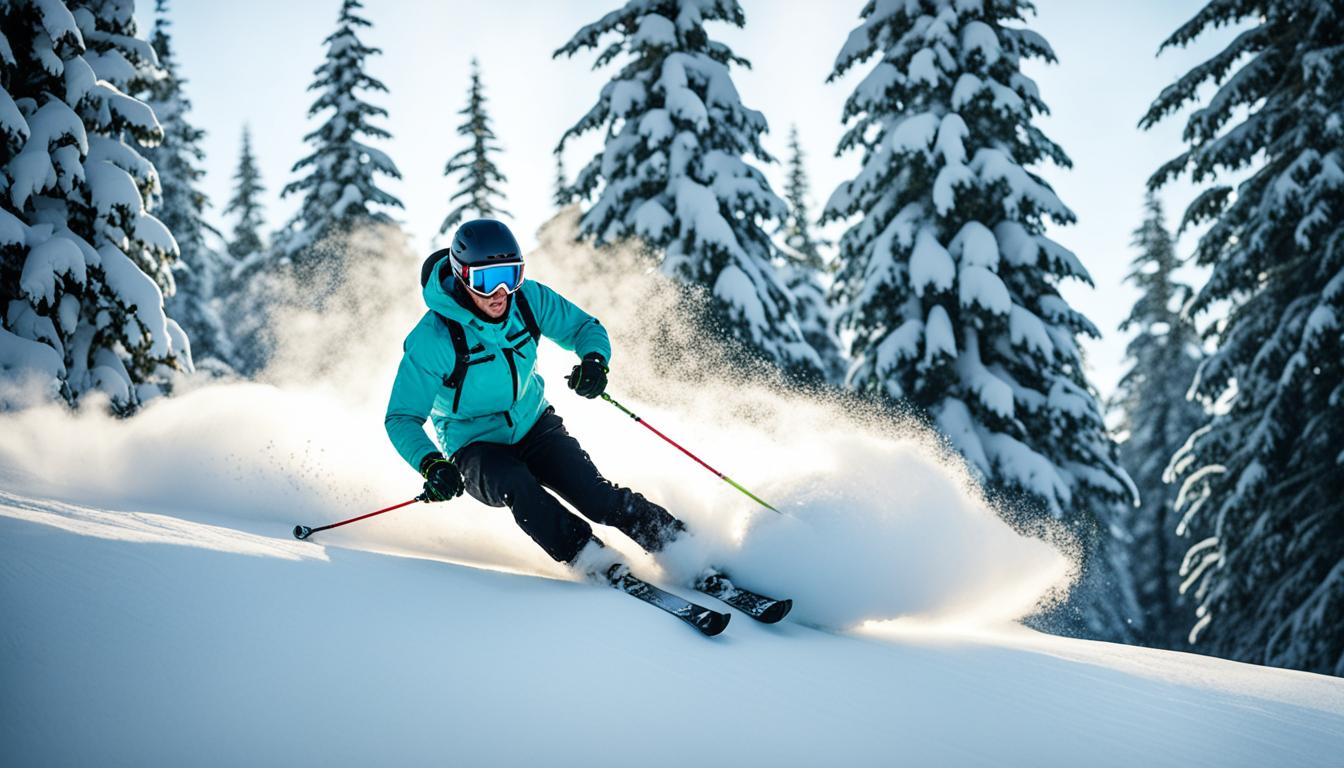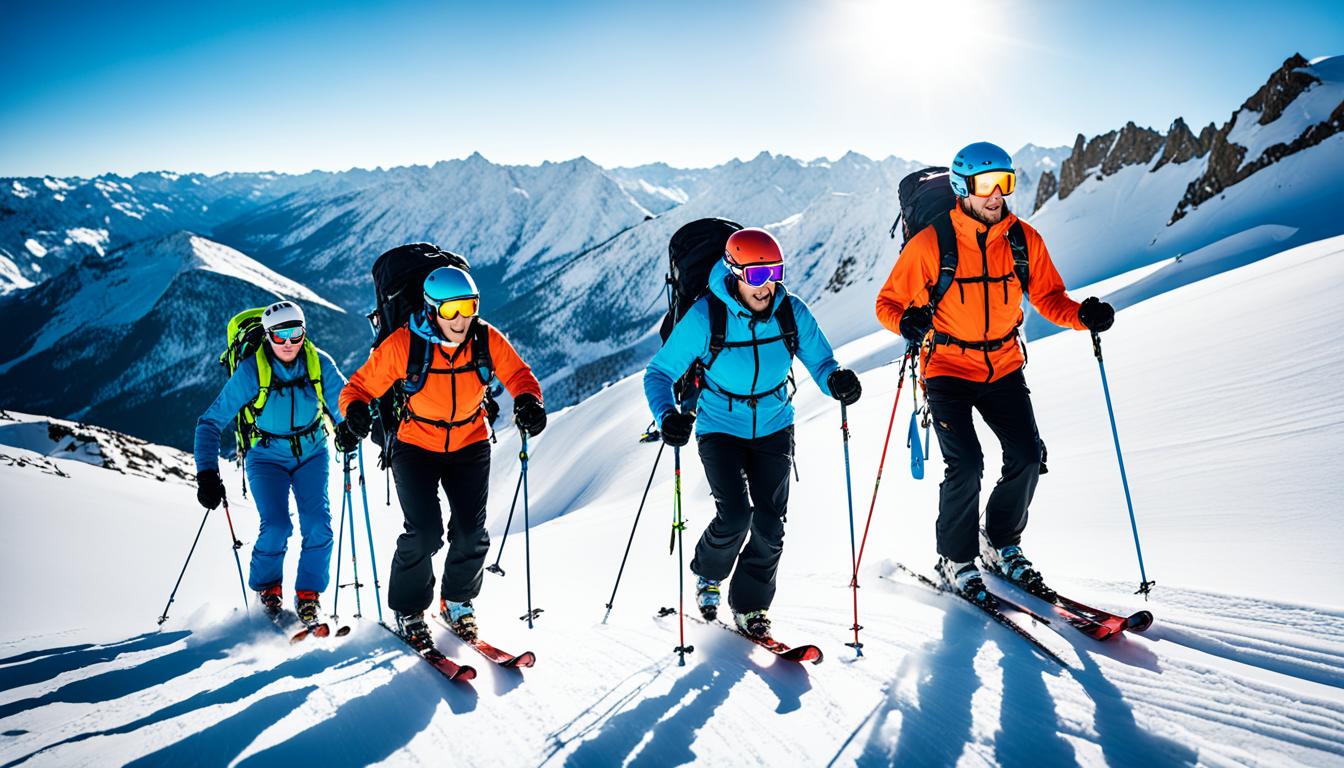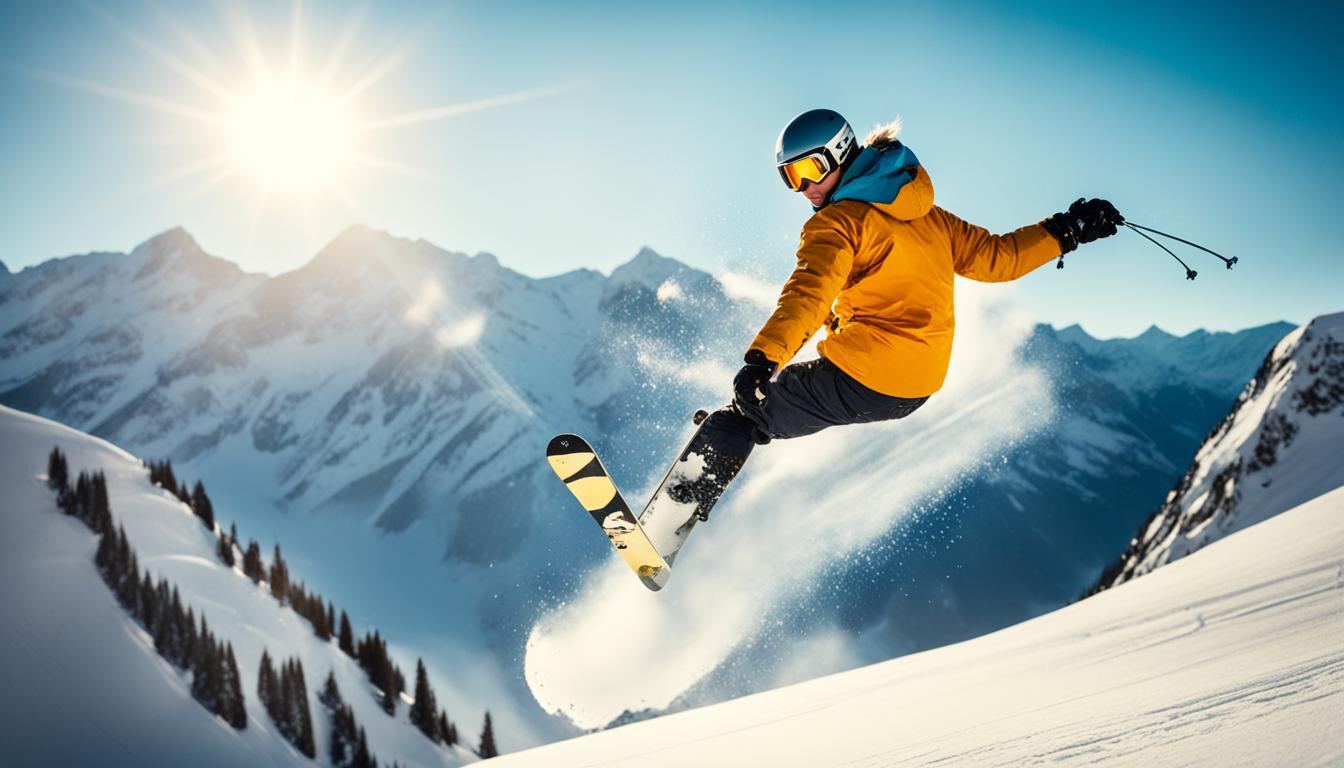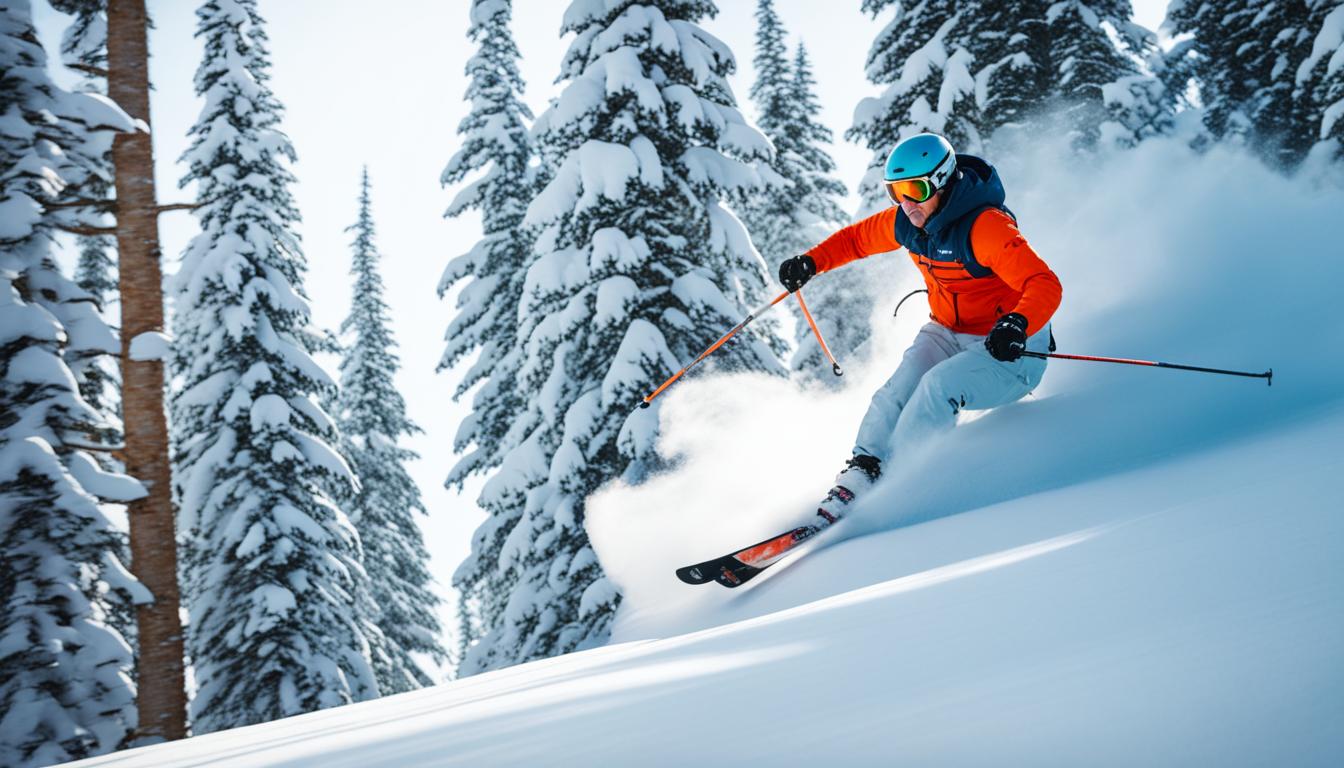When it comes to skiing in Colorado, the thrill of tree skiing is hard to beat. Gliding through powder-filled glades surrounded by the stunning beauty of the Rocky Mountains is an experience like no other. But as exhilarating as tree skiing can be, it’s important to prioritize safety and take precautions to minimize the risks involved.
One of the main hazards of tree skiing is the presence of tree wells – empty spaces around the base of trees that can trap skiers and riders. These hidden dangers can be fatal if not properly managed. That’s why we’re here to provide you with essential tips and safety guidelines to make your tree skiing adventure in Colorado both exciting and safe.
Key Takeaways:
- Be educated about tree well safety to reduce the risk of accidents.
- Carry essential safety equipment such as a cell phone, transceiver, whistle, shovel, and probe.
- Always ski with a partner and choose glades that are suitable for your skill level.
- Make quick, short turns and maintain focus on the spaces between the trees.
- Recognize the risks associated with tree wells and take preventive measures.
The Thrill of Tree Skiing in Colorado
Tree skiing in Colorado is renowned for its exhilaration and accessibility. The mountains in the United States and Canada offer excellent tree skiing opportunities due to their lower elevations compared to the Alps and South America’s ski resorts.
The glades in Colorado provide a variety of conditions, including powder, crud, and iced-over ruts. It is important to ski within your ability level and be prepared to encounter steep verticals, bumps, and other obstacles. Always ski with a partner and choose glades that are suitable for your skill level.
Whether you’re a beginner or an expert, tree skiing in Colorado offers something for everyone. The thrill of skiing through the dense forests, surrounded by breathtaking natural beauty, creates a sense of adventure and excitement that is hard to match.
Exploring the tree runs in Colorado allows you to experience the beauty of nature while challenging your skiing skills. The tree-lined slopes provide a sense of solitude and serenity, as well as a unique and thrilling skiing experience.
As you navigate through the glades, you’ll encounter a variety of terrain and snow conditions. From deep powder stashes to tight tree corridors, each run offers its own set of challenges and rewards.
Remember to always ski within your ability level and be aware of your surroundings. Tree skiing can be unpredictable, and it’s important to stay alert and adapt to changing conditions.
So, grab your skis and get ready for an unforgettable adventure in the Colorado mountains. Whether you’re a seasoned expert or a beginner looking to try something new, tree skiing in Colorado is an experience you won’t want to miss.
Tips for Safe Tree Skiing
When it comes to tree skiing, prioritizing safety is paramount. To ensure a thrilling and secure experience, we recommend the following:
- Master Tree Skiing Techniques: Make quick, short turns to navigate through the trees. Maintain your focus on the spaces between the trees rather than the trees themselves. This technique will help you navigate the glades with precision and agility.
- Skiing with Friends: Whenever possible, ski with two friends. This allows one person to stay with an injured skier while the other seeks help. The buddy system significantly enhances safety and ensures swift assistance in case of an emergency.
- Time Management: Avoid skiing alone and never enter gladed areas after 3:30 PM. By adhering to these guidelines, you minimize the risk of getting lost or injured in the dark, ensuring a safe return from the slopes.
- Essential Equipment: Protect yourself by wearing a reliable helmet and goggles to safeguard your head and eyes. Additionally, carry essential equipment, including a compass, trail map, water, and energy snacks to stay hydrated and nourished throughout your adventure.
Remember, safety should always be a top priority when indulging in the adrenaline-fueled world of tree skiing. By implementing these expert tree skiing tips and properly equipping yourself, you’ll be able to fully enjoy the thrill while minimizing potential risks.
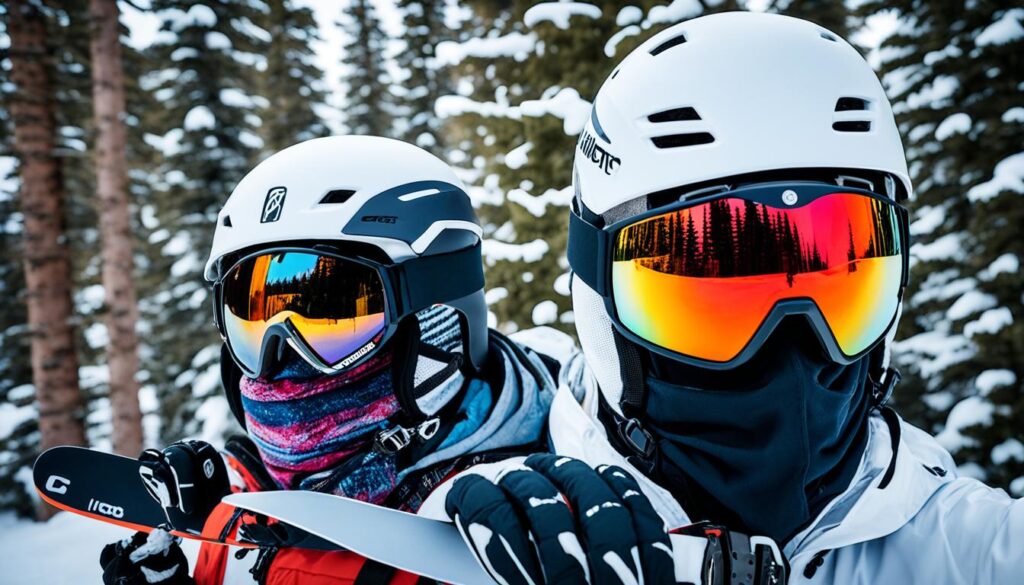
Understanding Tree Well Dangers
One of the most crucial hazards to be aware of when tree skiing is the presence of tree wells. These treacherous areas are formed by loose, uncompressed snow around the base of trees, concealed beneath low-hanging branches. Falling headfirst into a tree well can have severe consequences, including life-threatening situations. It is essential to recognize the risks associated with tree wells and take proactive measures to ensure safety.
When engaging in tree skiing, it is highly recommended to maintain a safe distance from trees to minimize the risk of falling into a tree well. Skiing with a buddy is also a crucial safety step, as they can provide immediate assistance in case of an accident. Remember, the buddy system can make all the difference in ensuring a safe and enjoyable tree skiing experience.
To further enhance your awareness and preparedness, there are many valuable resources available. The Northwest Avalanche Institute offers comprehensive information about skiing in deep snow and tree-infested areas. Additionally, renowned resorts such as Mt. Baker Ski Area and Crystal Mountain provide resources and safety information specific to their terrain. Familiarize yourself with these resources to gain critical insights and stay safe on the slopes.
Remember, prevention is key when it comes to tree well dangers. By understanding the risks, skiing cautiously, and leveraging the collective knowledge available, we can ensure a safe and thrilling tree skiing adventure in the beautiful mountains of Colorado.
Tree Skiing in the Eastern United States
While Colorado is known for its exceptional tree skiing, the Eastern United States also offers exciting opportunities. Resorts such as Mount Snow, Killington, Gore Mountain, and Bromley have designated tree runs suitable for different skill levels.
When venturing into the trees, it is crucial to prioritize safety. To ensure a safe and enjoyable experience, there are a few guidelines to follow:
- Ski with others: Always ski with a partner or in a group when exploring the tree runs. This ensures that there is someone to assist you in case of an emergency.
- Avoid pole straps: Consider using pole straps that easily release to minimize the risk of getting caught on branches or other obstacles while skiing through the trees.
- Wear goggles and a helmet: Protect your eyes and head by wearing goggles and a helmet. Goggles shield your eyes from tree branches and other debris, while a helmet provides essential protection in case of a fall or collision.
- Carry a whistle: Always have a whistle with you to signal for help in case of an emergency. It is a simple, yet effective way to attract attention and get assistance if needed.
By following these safety guidelines and skiing within your ability, you can still enjoy the thrill of tree skiing in the Eastern United States. Remember to be cautious, stay aware of your surroundings, and have a great time exploring the tree runs available at these resorts.
Conclusion
Tree skiing in Colorado is an exhilarating adventure that allows you to immerse yourself in the stunning natural beauty of the Rockies. However, it’s important to prioritize safety throughout your tree skiing experience. By following some key tips and being prepared, you can ensure a safe and enjoyable adventure.
Firstly, educating yourself about tree wells is crucial. These hidden dangers can pose a significant risk to skiers and riders. Understanding how to recognize and avoid tree wells, as well as carrying essential safety equipment like a cell phone, transceiver, whistle, shovel, and probe, can help minimize the potential for accidents.
Secondly, skiing within your ability level is vital. Tree skiing can be challenging, with steep verticals, bumps, and other obstacles to navigate. It’s important to choose glades that match your skill level and always ski with a partner for added safety.
By being aware of these tree skiing tips and safety measures, you can confidently explore the glades of Colorado and have an unforgettable tree skiing experience. So gear up, stay informed, and embrace the thrill of tree skiing in the beautiful landscapes of Colorado’s mountains.
FAQ
What is tree skiing?
Tree skiing is the practice of skiing or snowboarding off groomed runs and through gladed areas where there are trees. It provides a unique and thrilling experience for skiers and riders.
What are the risks associated with tree skiing?
Tree skiing comes with certain risks, including the danger of falling into tree wells, which are empty spaces around the base of trees that can trap skiers and riders. It is important to be aware of this hazard and take preventive measures to reduce the risk of accidents.
What safety equipment is recommended for tree skiing?
When tree skiing, it is crucial to carry safety equipment such as a cell phone, transceiver, whistle, shovel, and probe. These tools can be essential for communication, search and rescue, and digging out of potential hazards.
How should I ski in the trees?
When skiing in the trees, it is important to make quick, short turns and focus on the spaces between the trees rather than the trees themselves. This will help you navigate through the glades more smoothly and reduce the risk of collisions.
Is it safe to ski alone in the trees?
It is not recommended to ski alone in the trees. Always ski with a partner or a group, as this ensures that there is someone to assist in case of an emergency or injury.
How can I avoid tree wells?
To avoid falling into tree wells, maintain a safe distance from trees when skiing and ride with a buddy. This can help reduce the risk of accidentally falling into a tree well.
Are there any resources available for tree skiing safety?
Yes, organizations like the Northwest Avalanche Institute and ski resorts such as Mt. Baker Ski Area and Crystal Mountain offer resources and safety information for skiing in deep snow and tree-infested areas. It is recommended to familiarize yourself with these resources before heading out to the slopes.
Can I go tree skiing in the Eastern United States?
Yes, there are several resorts in the Eastern United States that offer designated tree runs suitable for different skill levels. Resorts such as Mount Snow, Killington, Gore Mountain, and Bromley provide opportunities for tree skiing. However, it is important to follow safety guidelines and ski within your ability to ensure a safe experience.
How can I ski safely as I age?
To ski safely as you age, it is important to ski within your ability level and be cautious while navigating through the trees. It is also recommended to follow safety guidelines such as skiing with others, avoiding pole straps, and carrying essential safety equipment like a whistle for emergencies.

